Assessment of Psychotropic Medications in Healthcare
VerifiedAdded on 2023/03/30
|12
|1062
|389
Presentation
AI Summary
This presentation provides an assessment of psychotropic medications and their use in healthcare. It covers various types of medications, including antipsychotic, antidepressant, mood stabilizer, anti-anxiety, and substance abuse treatment agents. The presentation also discusses the role of mental health therapy in conjunction with medication agents.
Contribute Materials
Your contribution can guide someone’s learning journey. Share your
documents today.
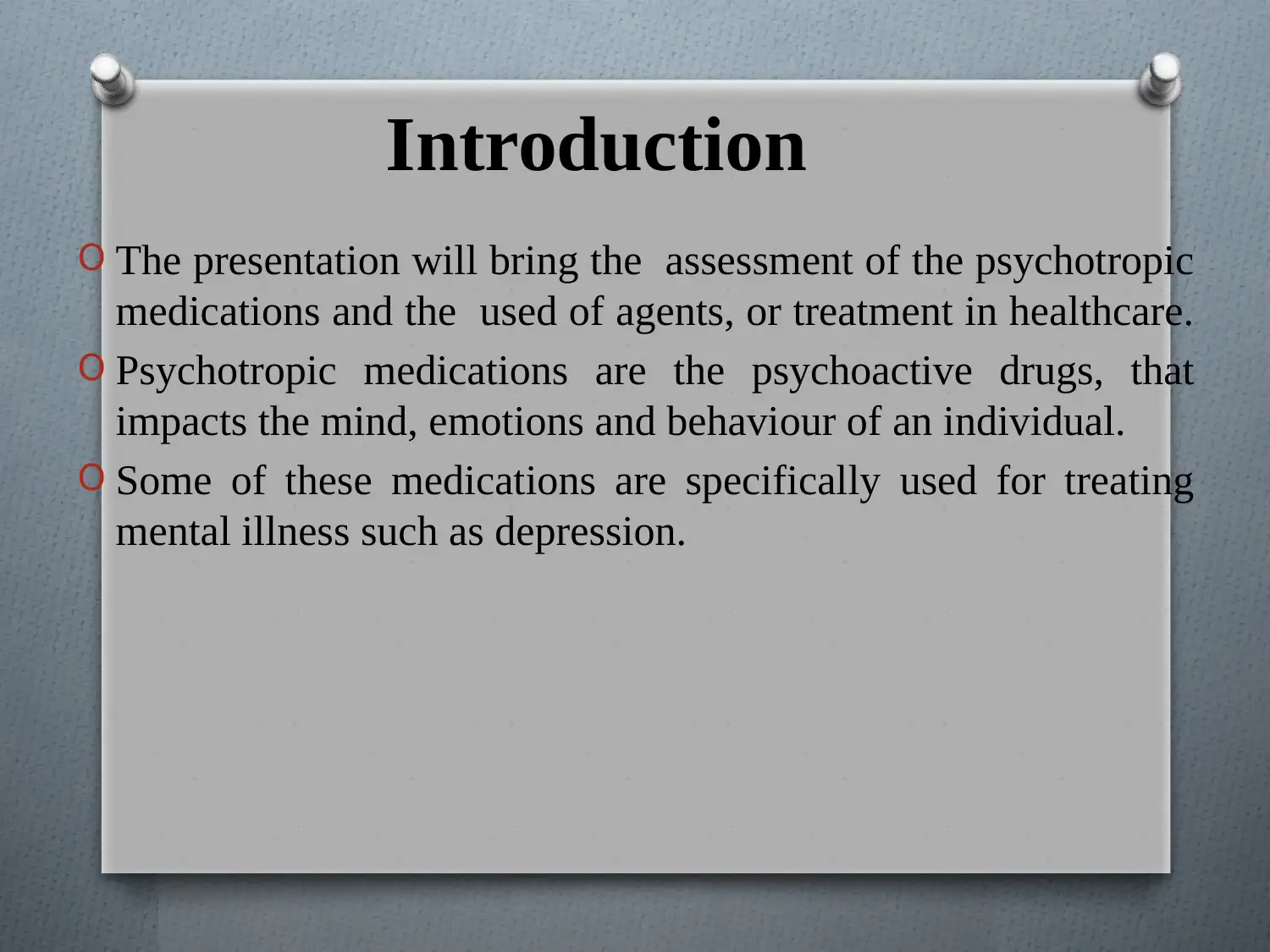
Introduction
O The presentation will bring the assessment of the psychotropic
medications and the used of agents, or treatment in healthcare.
O Psychotropic medications are the psychoactive drugs, that
impacts the mind, emotions and behaviour of an individual.
O Some of these medications are specifically used for treating
mental illness such as depression.
O The presentation will bring the assessment of the psychotropic
medications and the used of agents, or treatment in healthcare.
O Psychotropic medications are the psychoactive drugs, that
impacts the mind, emotions and behaviour of an individual.
O Some of these medications are specifically used for treating
mental illness such as depression.
Secure Best Marks with AI Grader
Need help grading? Try our AI Grader for instant feedback on your assignments.
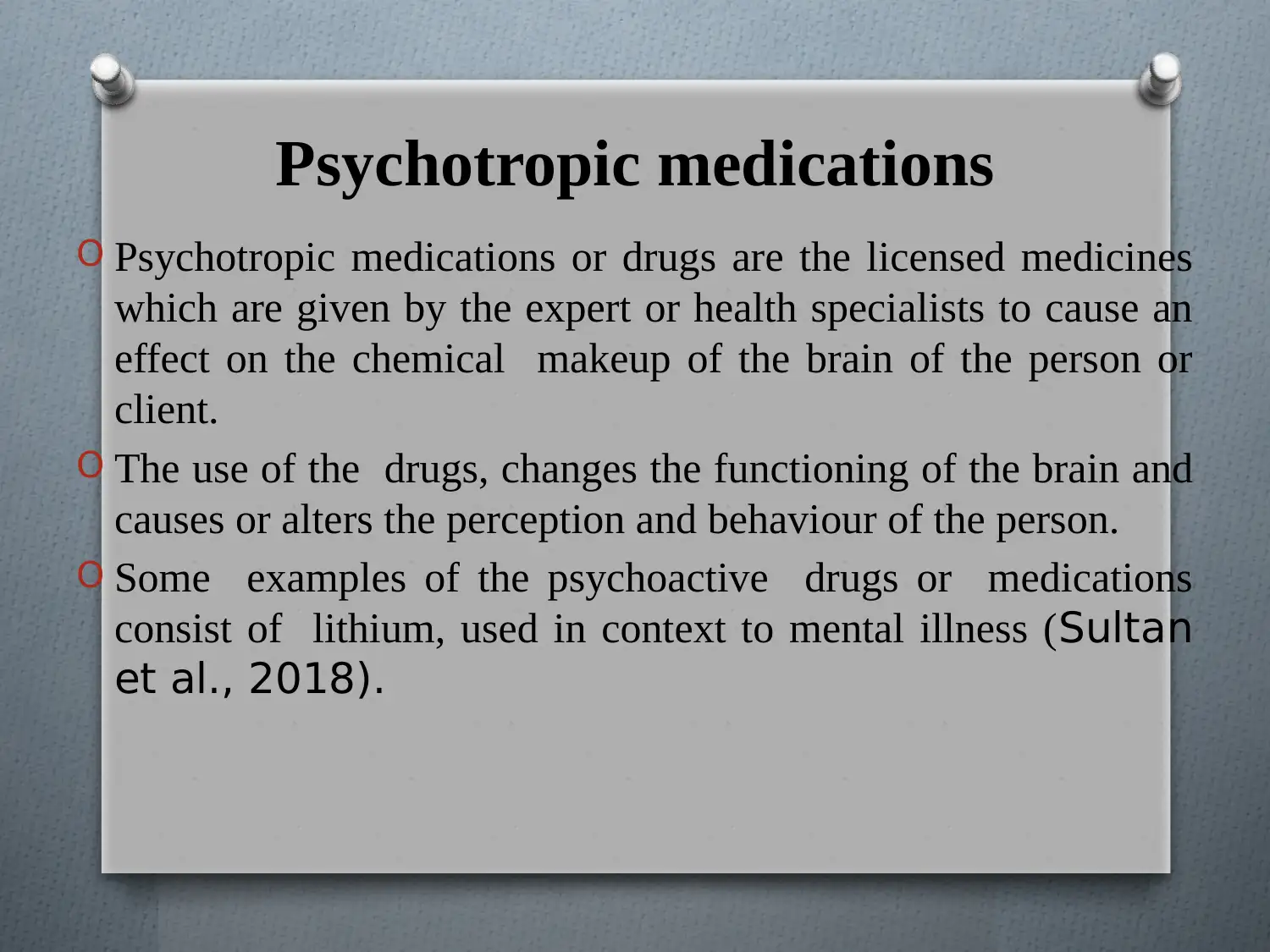
Psychotropic medications
O Psychotropic medications or drugs are the licensed medicines
which are given by the expert or health specialists to cause an
effect on the chemical makeup of the brain of the person or
client.
O The use of the drugs, changes the functioning of the brain and
causes or alters the perception and behaviour of the person.
O Some examples of the psychoactive drugs or medications
consist of lithium, used in context to mental illness (Sultan
et al., 2018).
O Psychotropic medications or drugs are the licensed medicines
which are given by the expert or health specialists to cause an
effect on the chemical makeup of the brain of the person or
client.
O The use of the drugs, changes the functioning of the brain and
causes or alters the perception and behaviour of the person.
O Some examples of the psychoactive drugs or medications
consist of lithium, used in context to mental illness (Sultan
et al., 2018).
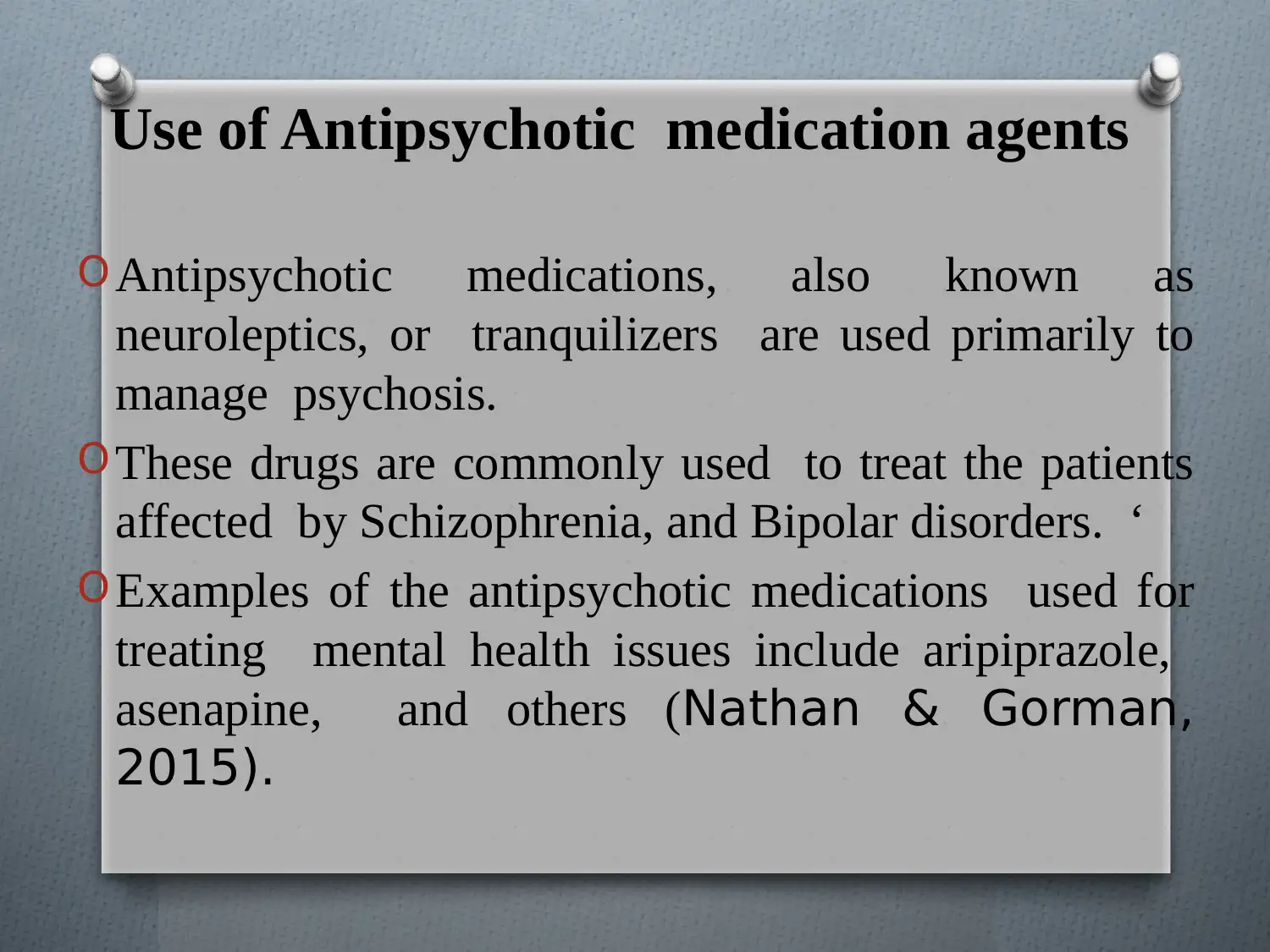
Use of Antipsychotic medication agents
O Antipsychotic medications, also known as
neuroleptics, or tranquilizers are used primarily to
manage psychosis.
O These drugs are commonly used to treat the patients
affected by Schizophrenia, and Bipolar disorders. ‘
O Examples of the antipsychotic medications used for
treating mental health issues include aripiprazole,
asenapine, and others (Nathan & Gorman,
2015).
O Antipsychotic medications, also known as
neuroleptics, or tranquilizers are used primarily to
manage psychosis.
O These drugs are commonly used to treat the patients
affected by Schizophrenia, and Bipolar disorders. ‘
O Examples of the antipsychotic medications used for
treating mental health issues include aripiprazole,
asenapine, and others (Nathan & Gorman,
2015).
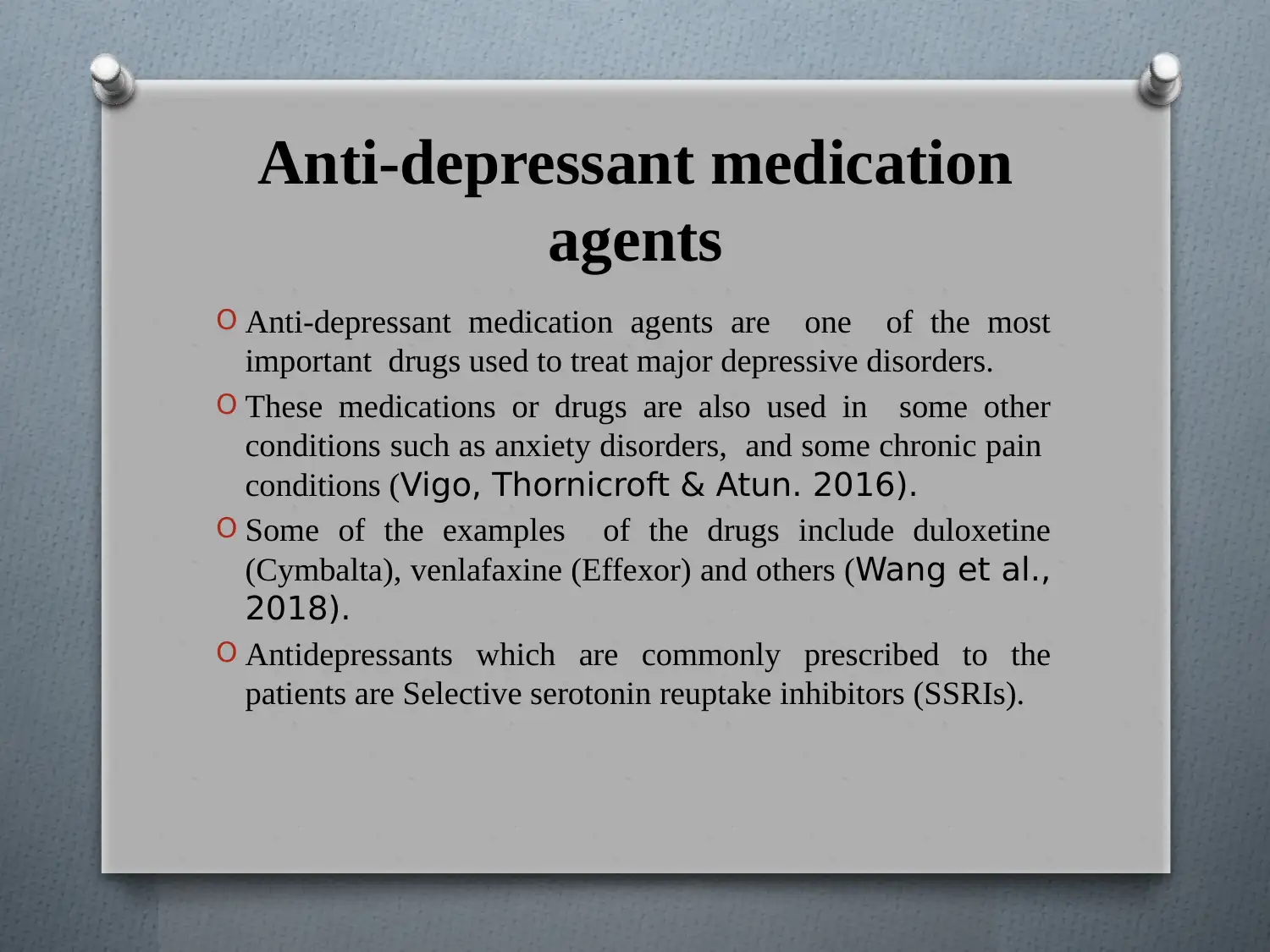
Anti-depressant medication
agents
O Anti-depressant medication agents are one of the most
important drugs used to treat major depressive disorders.
O These medications or drugs are also used in some other
conditions such as anxiety disorders, and some chronic pain
conditions (Vigo, Thornicroft & Atun. 2016).
O Some of the examples of the drugs include duloxetine
(Cymbalta), venlafaxine (Effexor) and others (Wang et al.,
2018).
O Antidepressants which are commonly prescribed to the
patients are Selective serotonin reuptake inhibitors (SSRIs).
agents
O Anti-depressant medication agents are one of the most
important drugs used to treat major depressive disorders.
O These medications or drugs are also used in some other
conditions such as anxiety disorders, and some chronic pain
conditions (Vigo, Thornicroft & Atun. 2016).
O Some of the examples of the drugs include duloxetine
(Cymbalta), venlafaxine (Effexor) and others (Wang et al.,
2018).
O Antidepressants which are commonly prescribed to the
patients are Selective serotonin reuptake inhibitors (SSRIs).
Secure Best Marks with AI Grader
Need help grading? Try our AI Grader for instant feedback on your assignments.
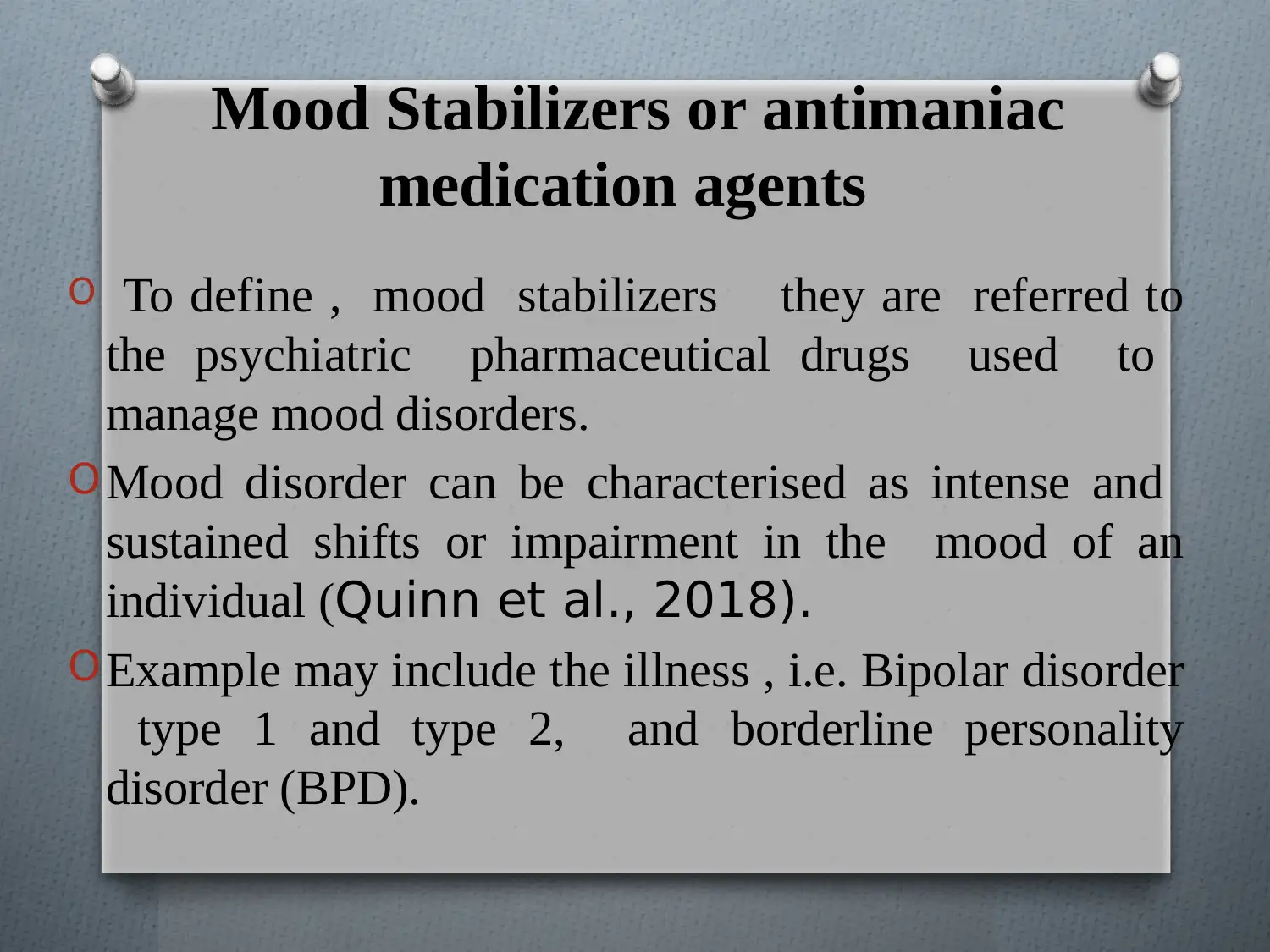
Mood Stabilizers or antimaniac
medication agents
O To define , mood stabilizers they are referred to
the psychiatric pharmaceutical drugs used to
manage mood disorders.
O Mood disorder can be characterised as intense and
sustained shifts or impairment in the mood of an
individual (Quinn et al., 2018).
O Example may include the illness , i.e. Bipolar disorder
type 1 and type 2, and borderline personality
disorder (BPD).
medication agents
O To define , mood stabilizers they are referred to
the psychiatric pharmaceutical drugs used to
manage mood disorders.
O Mood disorder can be characterised as intense and
sustained shifts or impairment in the mood of an
individual (Quinn et al., 2018).
O Example may include the illness , i.e. Bipolar disorder
type 1 and type 2, and borderline personality
disorder (BPD).
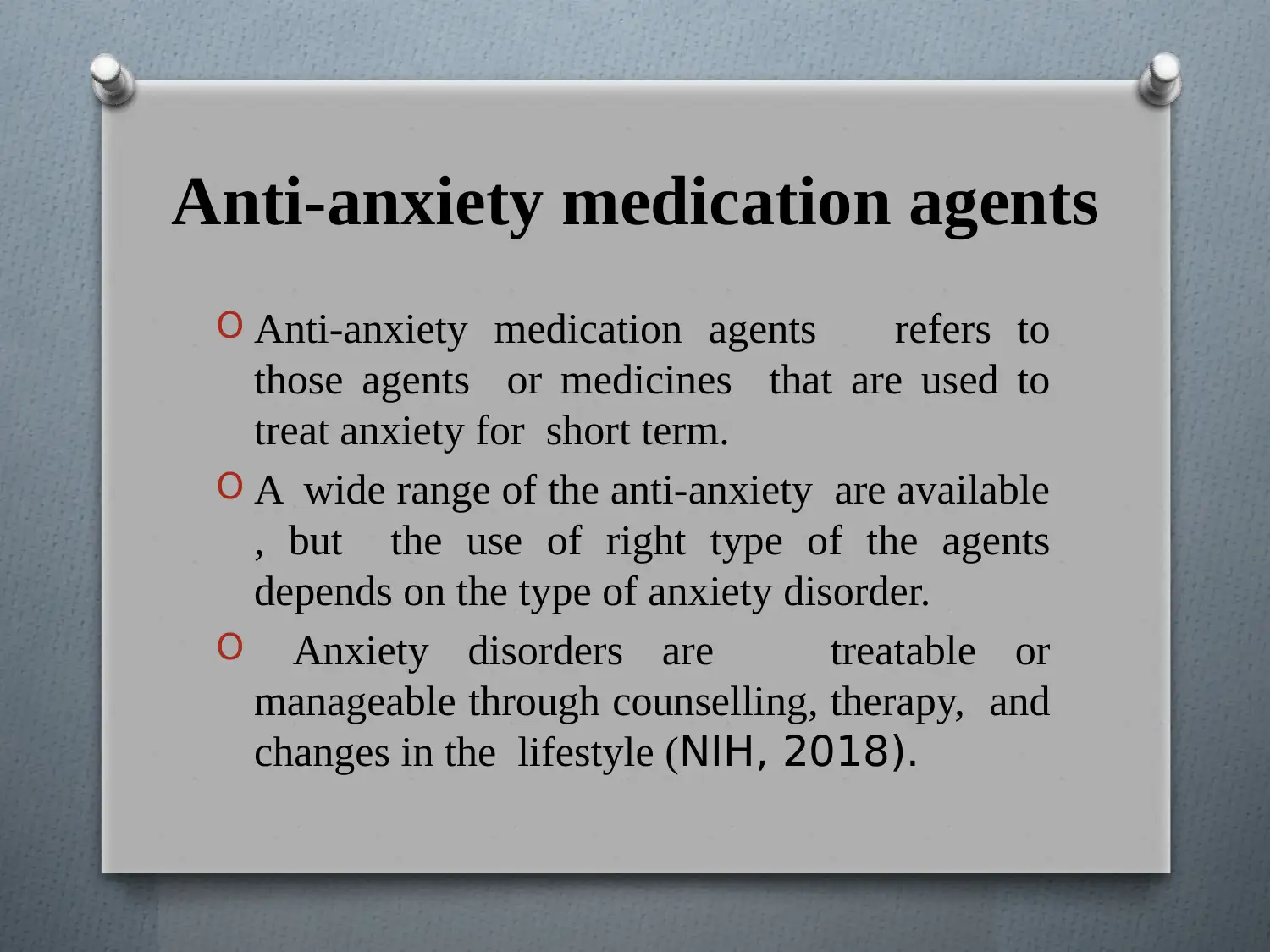
Anti-anxiety medication agents
O Anti-anxiety medication agents refers to
those agents or medicines that are used to
treat anxiety for short term.
O A wide range of the anti-anxiety are available
, but the use of right type of the agents
depends on the type of anxiety disorder.
O Anxiety disorders are treatable or
manageable through counselling, therapy, and
changes in the lifestyle (NIH, 2018).
O Anti-anxiety medication agents refers to
those agents or medicines that are used to
treat anxiety for short term.
O A wide range of the anti-anxiety are available
, but the use of right type of the agents
depends on the type of anxiety disorder.
O Anxiety disorders are treatable or
manageable through counselling, therapy, and
changes in the lifestyle (NIH, 2018).
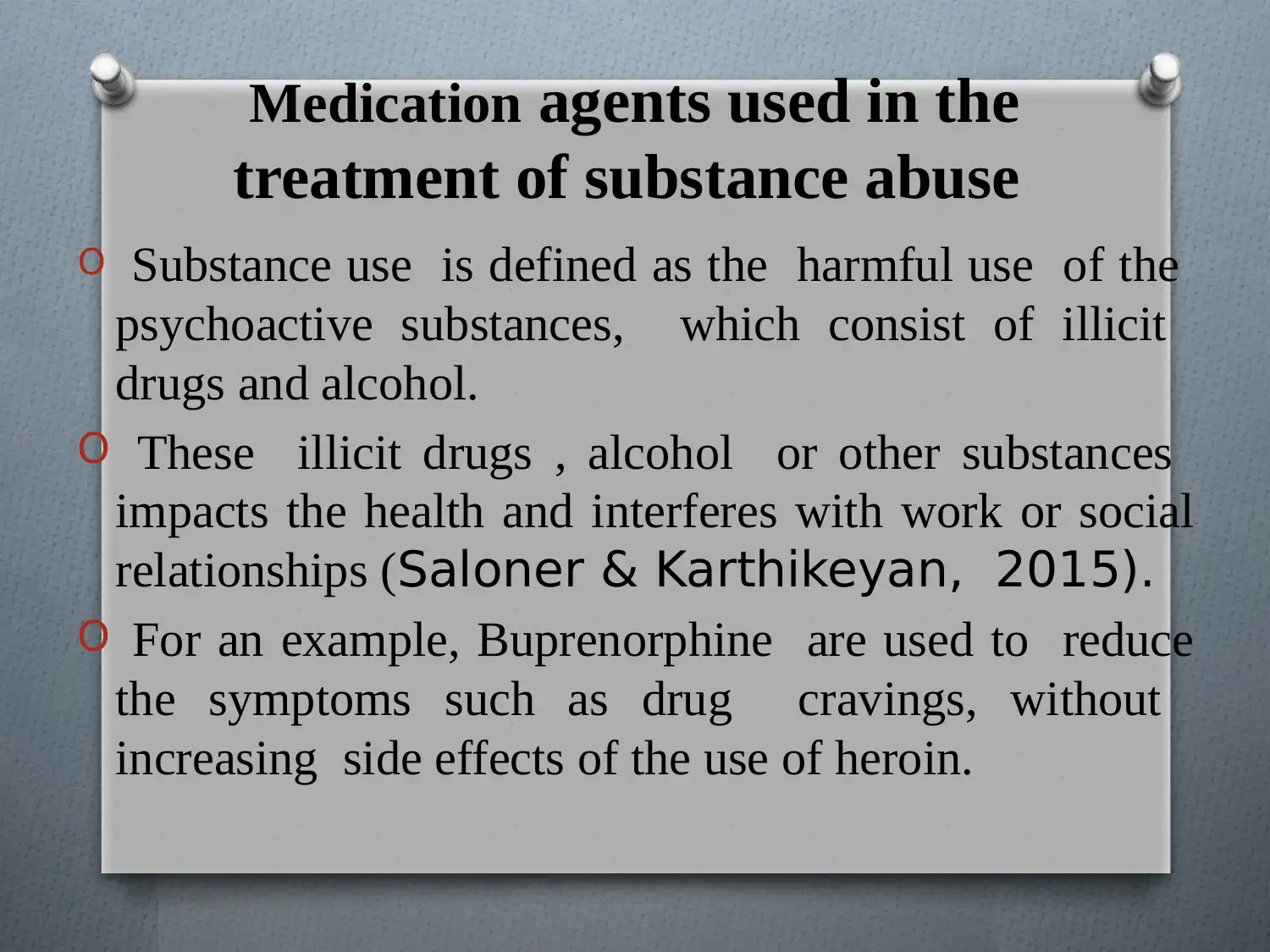
Medication agents used in the
treatment of substance abuse
O Substance use is defined as the harmful use of the
psychoactive substances, which consist of illicit
drugs and alcohol.
O These illicit drugs , alcohol or other substances
impacts the health and interferes with work or social
relationships (Saloner & Karthikeyan, 2015).
O For an example, Buprenorphine are used to reduce
the symptoms such as drug cravings, without
increasing side effects of the use of heroin.
treatment of substance abuse
O Substance use is defined as the harmful use of the
psychoactive substances, which consist of illicit
drugs and alcohol.
O These illicit drugs , alcohol or other substances
impacts the health and interferes with work or social
relationships (Saloner & Karthikeyan, 2015).
O For an example, Buprenorphine are used to reduce
the symptoms such as drug cravings, without
increasing side effects of the use of heroin.
Paraphrase This Document
Need a fresh take? Get an instant paraphrase of this document with our AI Paraphraser
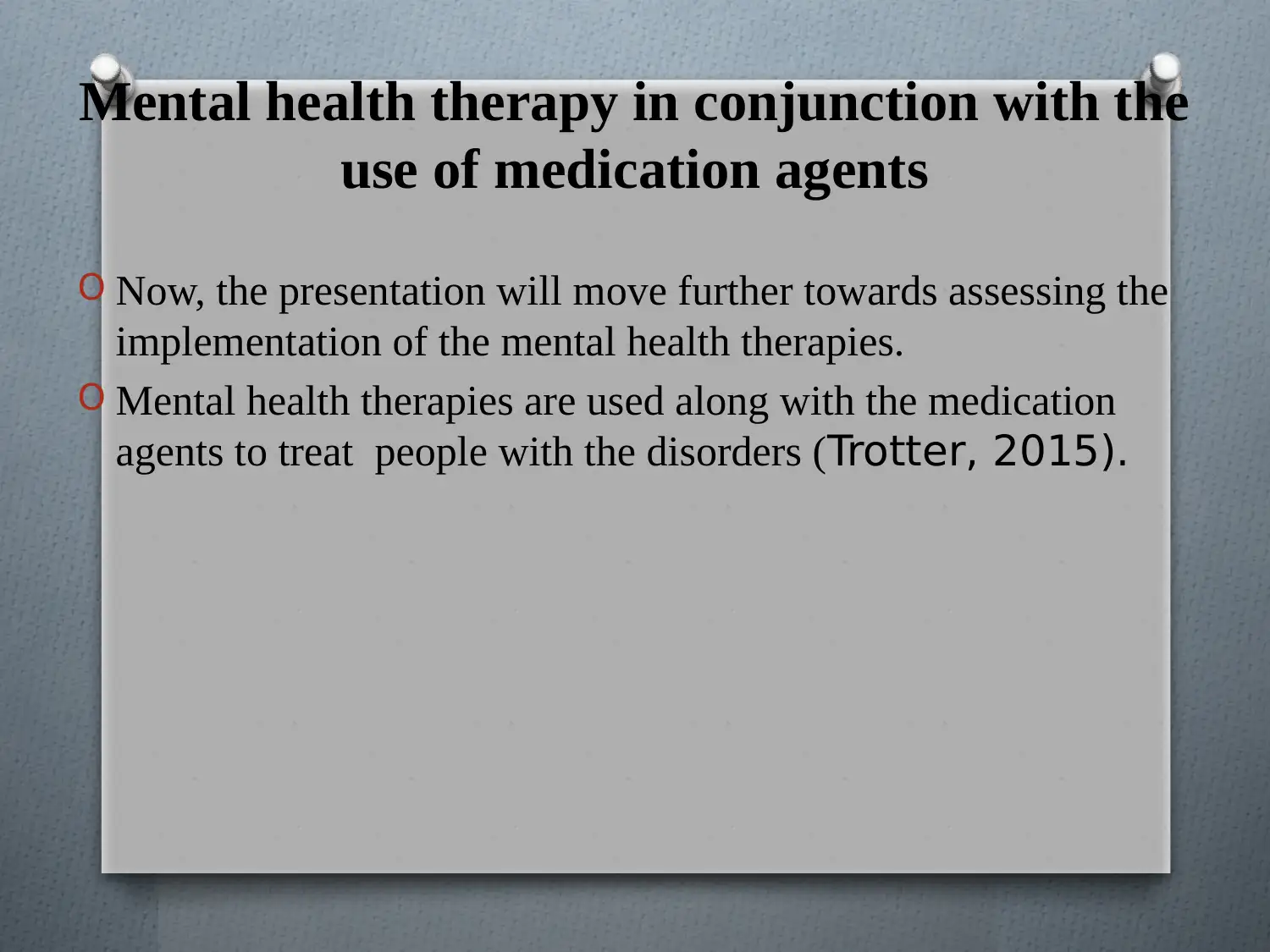
Mental health therapy in conjunction with the
use of medication agents
O Now, the presentation will move further towards assessing the
implementation of the mental health therapies.
O Mental health therapies are used along with the medication
agents to treat people with the disorders (Trotter, 2015).
use of medication agents
O Now, the presentation will move further towards assessing the
implementation of the mental health therapies.
O Mental health therapies are used along with the medication
agents to treat people with the disorders (Trotter, 2015).
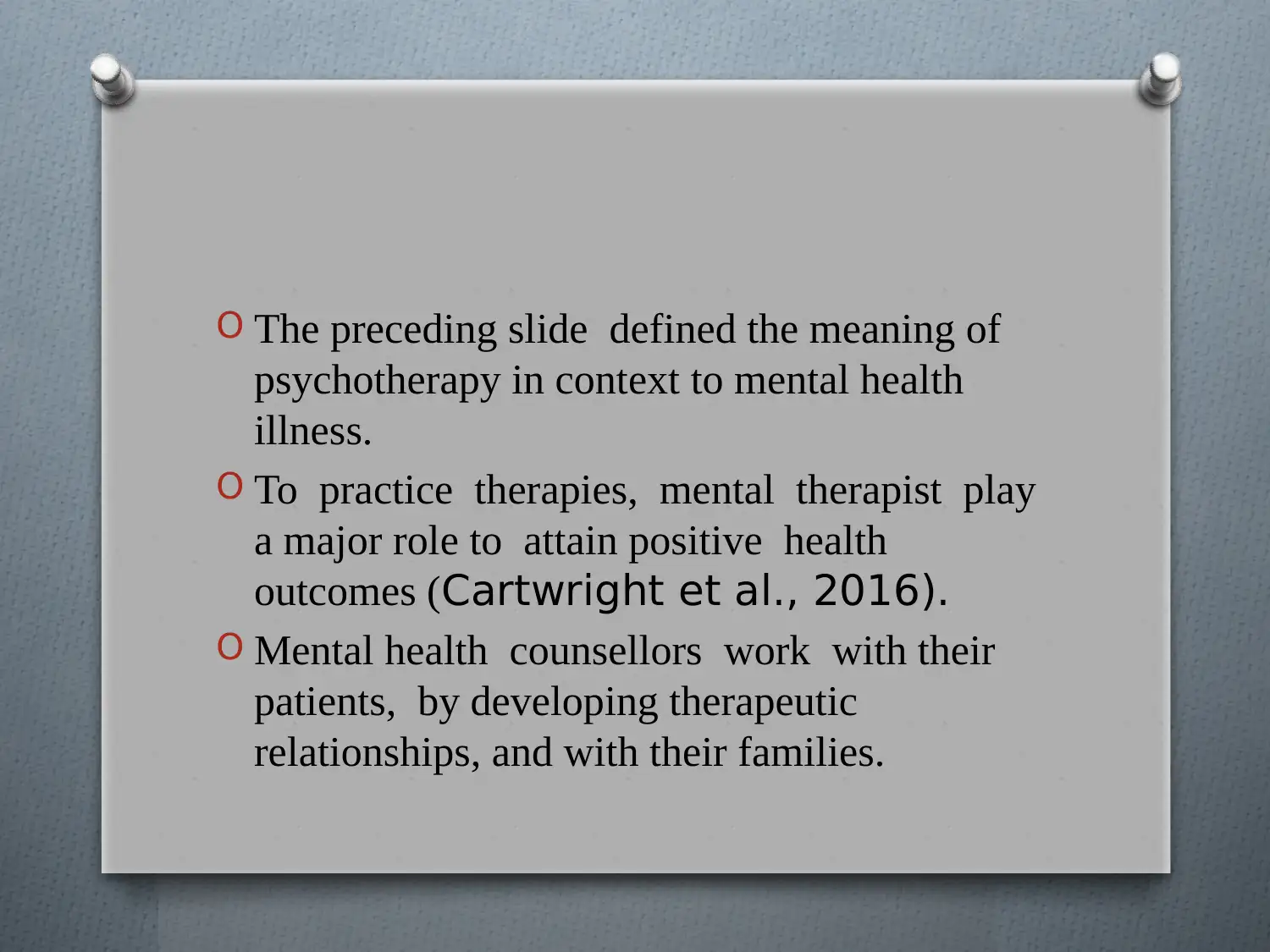
O The preceding slide defined the meaning of
psychotherapy in context to mental health
illness.
O To practice therapies, mental therapist play
a major role to attain positive health
outcomes (Cartwright et al., 2016).
O Mental health counsellors work with their
patients, by developing therapeutic
relationships, and with their families.
psychotherapy in context to mental health
illness.
O To practice therapies, mental therapist play
a major role to attain positive health
outcomes (Cartwright et al., 2016).
O Mental health counsellors work with their
patients, by developing therapeutic
relationships, and with their families.
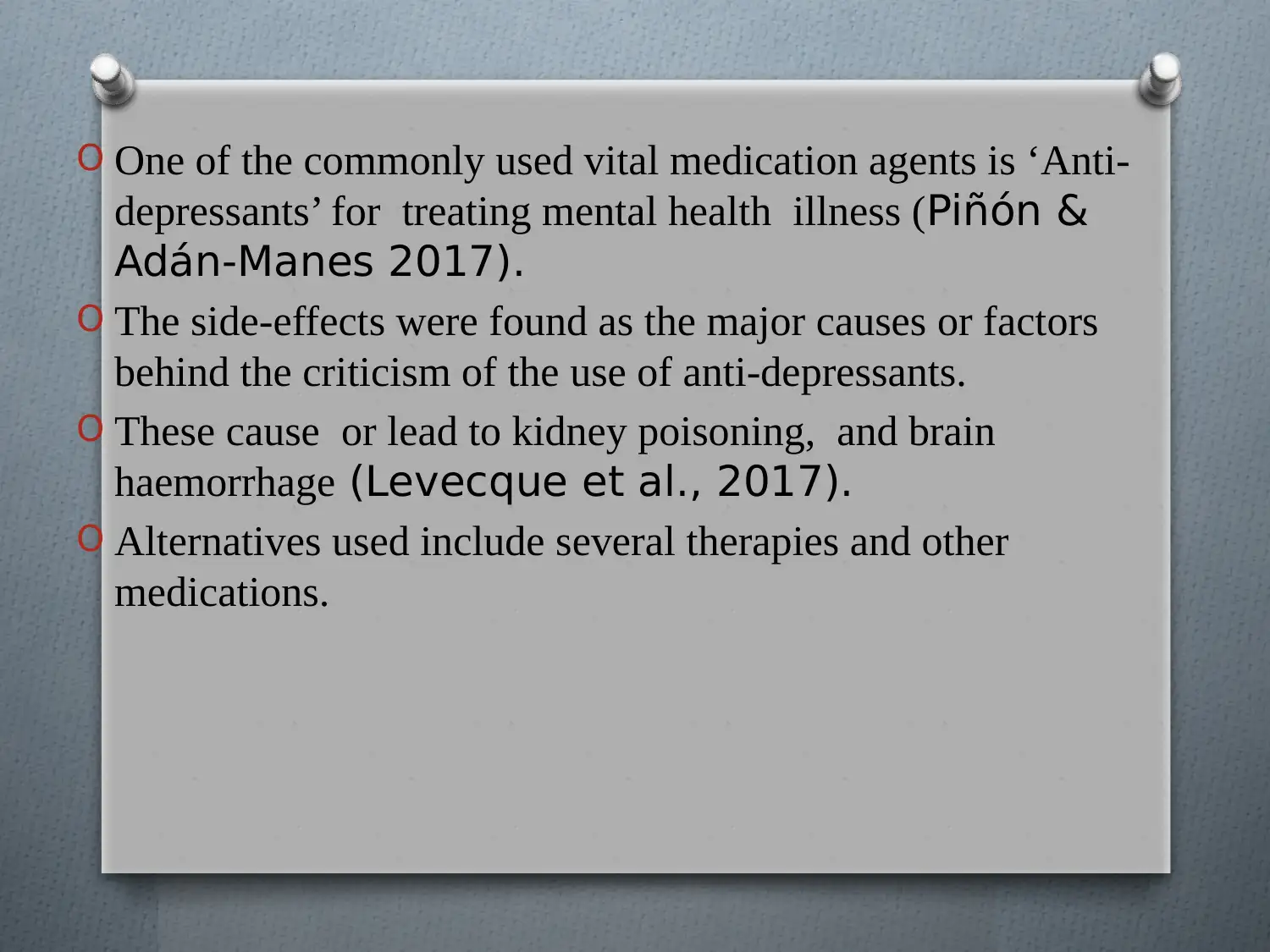
O One of the commonly used vital medication agents is ‘Anti-
depressants’ for treating mental health illness (Piñón &
Adán-Manes 2017).
O The side-effects were found as the major causes or factors
behind the criticism of the use of anti-depressants.
O These cause or lead to kidney poisoning, and brain
haemorrhage (Levecque et al., 2017).
O Alternatives used include several therapies and other
medications.
depressants’ for treating mental health illness (Piñón &
Adán-Manes 2017).
O The side-effects were found as the major causes or factors
behind the criticism of the use of anti-depressants.
O These cause or lead to kidney poisoning, and brain
haemorrhage (Levecque et al., 2017).
O Alternatives used include several therapies and other
medications.
Secure Best Marks with AI Grader
Need help grading? Try our AI Grader for instant feedback on your assignments.
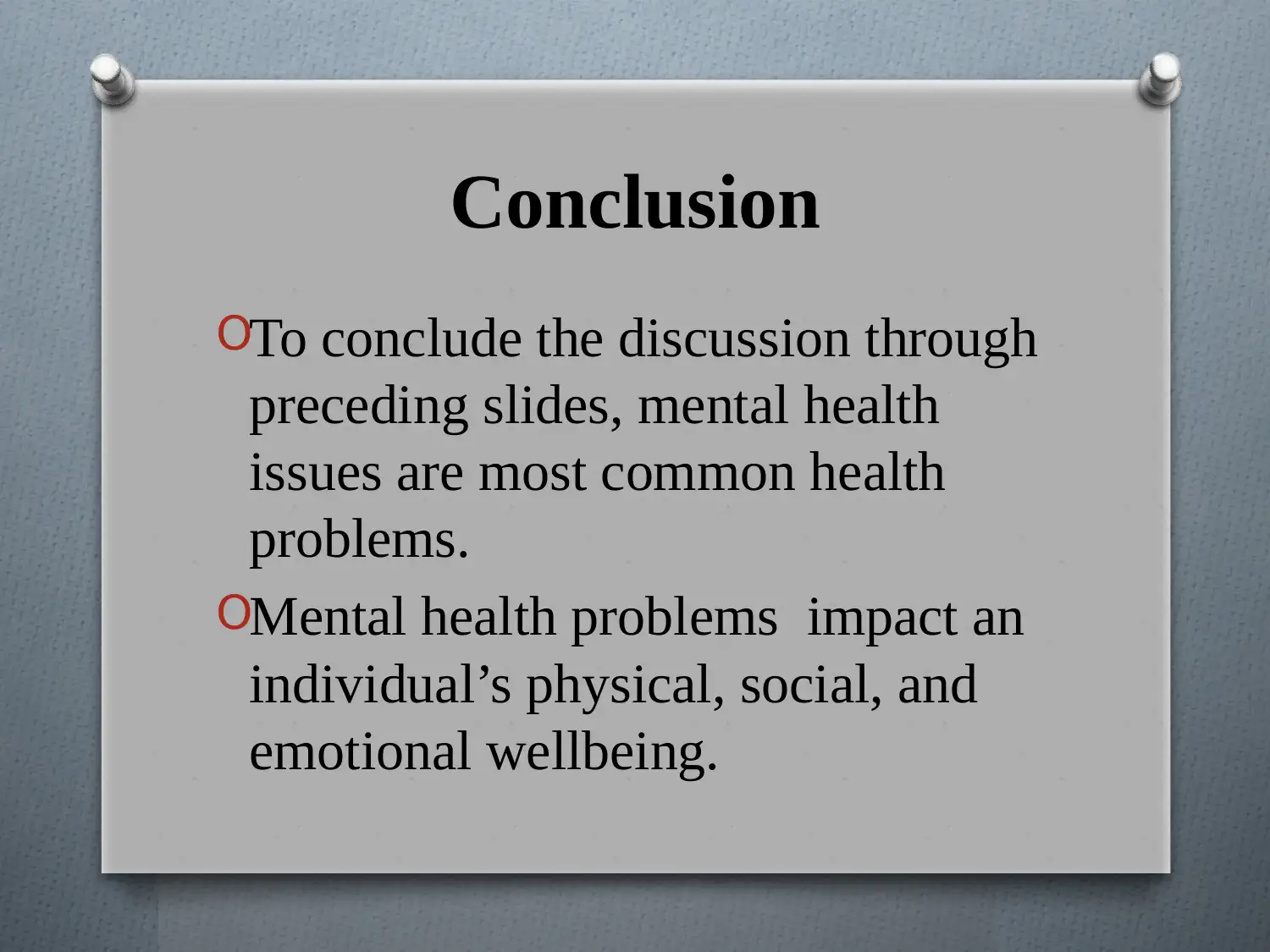
Conclusion
OTo conclude the discussion through
preceding slides, mental health
issues are most common health
problems.
OMental health problems impact an
individual’s physical, social, and
emotional wellbeing.
OTo conclude the discussion through
preceding slides, mental health
issues are most common health
problems.
OMental health problems impact an
individual’s physical, social, and
emotional wellbeing.
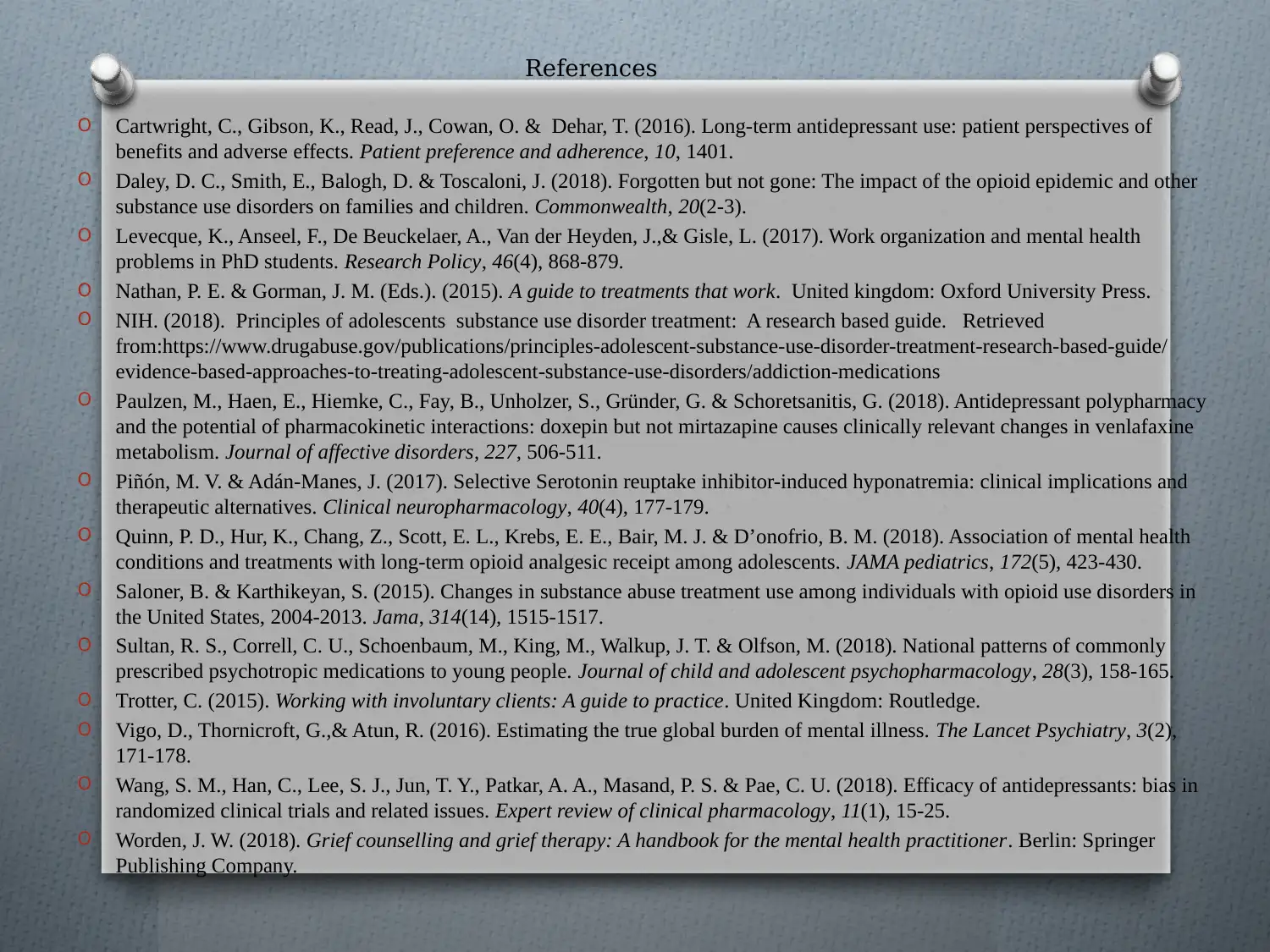
References
O Cartwright, C., Gibson, K., Read, J., Cowan, O. & Dehar, T. (2016). Long-term antidepressant use: patient perspectives of
benefits and adverse effects. Patient preference and adherence, 10, 1401.
O Daley, D. C., Smith, E., Balogh, D. & Toscaloni, J. (2018). Forgotten but not gone: The impact of the opioid epidemic and other
substance use disorders on families and children. Commonwealth, 20(2-3).
O Levecque, K., Anseel, F., De Beuckelaer, A., Van der Heyden, J.,& Gisle, L. (2017). Work organization and mental health
problems in PhD students. Research Policy, 46(4), 868-879.
O Nathan, P. E. & Gorman, J. M. (Eds.). (2015). A guide to treatments that work. United kingdom: Oxford University Press.
O NIH. (2018). Principles of adolescents substance use disorder treatment: A research based guide. Retrieved
from:https://www.drugabuse.gov/publications/principles-adolescent-substance-use-disorder-treatment-research-based-guide/
evidence-based-approaches-to-treating-adolescent-substance-use-disorders/addiction-medications
O Paulzen, M., Haen, E., Hiemke, C., Fay, B., Unholzer, S., Gründer, G. & Schoretsanitis, G. (2018). Antidepressant polypharmacy
and the potential of pharmacokinetic interactions: doxepin but not mirtazapine causes clinically relevant changes in venlafaxine
metabolism. Journal of affective disorders, 227, 506-511.
O Piñón, M. V. & Adán-Manes, J. (2017). Selective Serotonin reuptake inhibitor-induced hyponatremia: clinical implications and
therapeutic alternatives. Clinical neuropharmacology, 40(4), 177-179.
O Quinn, P. D., Hur, K., Chang, Z., Scott, E. L., Krebs, E. E., Bair, M. J. & D’onofrio, B. M. (2018). Association of mental health
conditions and treatments with long-term opioid analgesic receipt among adolescents. JAMA pediatrics, 172(5), 423-430.
O Saloner, B. & Karthikeyan, S. (2015). Changes in substance abuse treatment use among individuals with opioid use disorders in
the United States, 2004-2013. Jama, 314(14), 1515-1517.
O Sultan, R. S., Correll, C. U., Schoenbaum, M., King, M., Walkup, J. T. & Olfson, M. (2018). National patterns of commonly
prescribed psychotropic medications to young people. Journal of child and adolescent psychopharmacology, 28(3), 158-165.
O Trotter, C. (2015). Working with involuntary clients: A guide to practice. United Kingdom: Routledge.
O Vigo, D., Thornicroft, G.,& Atun, R. (2016). Estimating the true global burden of mental illness. The Lancet Psychiatry, 3(2),
171-178.
O Wang, S. M., Han, C., Lee, S. J., Jun, T. Y., Patkar, A. A., Masand, P. S. & Pae, C. U. (2018). Efficacy of antidepressants: bias in
randomized clinical trials and related issues. Expert review of clinical pharmacology, 11(1), 15-25.
O Worden, J. W. (2018). Grief counselling and grief therapy: A handbook for the mental health practitioner. Berlin: Springer
Publishing Company.
O Cartwright, C., Gibson, K., Read, J., Cowan, O. & Dehar, T. (2016). Long-term antidepressant use: patient perspectives of
benefits and adverse effects. Patient preference and adherence, 10, 1401.
O Daley, D. C., Smith, E., Balogh, D. & Toscaloni, J. (2018). Forgotten but not gone: The impact of the opioid epidemic and other
substance use disorders on families and children. Commonwealth, 20(2-3).
O Levecque, K., Anseel, F., De Beuckelaer, A., Van der Heyden, J.,& Gisle, L. (2017). Work organization and mental health
problems in PhD students. Research Policy, 46(4), 868-879.
O Nathan, P. E. & Gorman, J. M. (Eds.). (2015). A guide to treatments that work. United kingdom: Oxford University Press.
O NIH. (2018). Principles of adolescents substance use disorder treatment: A research based guide. Retrieved
from:https://www.drugabuse.gov/publications/principles-adolescent-substance-use-disorder-treatment-research-based-guide/
evidence-based-approaches-to-treating-adolescent-substance-use-disorders/addiction-medications
O Paulzen, M., Haen, E., Hiemke, C., Fay, B., Unholzer, S., Gründer, G. & Schoretsanitis, G. (2018). Antidepressant polypharmacy
and the potential of pharmacokinetic interactions: doxepin but not mirtazapine causes clinically relevant changes in venlafaxine
metabolism. Journal of affective disorders, 227, 506-511.
O Piñón, M. V. & Adán-Manes, J. (2017). Selective Serotonin reuptake inhibitor-induced hyponatremia: clinical implications and
therapeutic alternatives. Clinical neuropharmacology, 40(4), 177-179.
O Quinn, P. D., Hur, K., Chang, Z., Scott, E. L., Krebs, E. E., Bair, M. J. & D’onofrio, B. M. (2018). Association of mental health
conditions and treatments with long-term opioid analgesic receipt among adolescents. JAMA pediatrics, 172(5), 423-430.
O Saloner, B. & Karthikeyan, S. (2015). Changes in substance abuse treatment use among individuals with opioid use disorders in
the United States, 2004-2013. Jama, 314(14), 1515-1517.
O Sultan, R. S., Correll, C. U., Schoenbaum, M., King, M., Walkup, J. T. & Olfson, M. (2018). National patterns of commonly
prescribed psychotropic medications to young people. Journal of child and adolescent psychopharmacology, 28(3), 158-165.
O Trotter, C. (2015). Working with involuntary clients: A guide to practice. United Kingdom: Routledge.
O Vigo, D., Thornicroft, G.,& Atun, R. (2016). Estimating the true global burden of mental illness. The Lancet Psychiatry, 3(2),
171-178.
O Wang, S. M., Han, C., Lee, S. J., Jun, T. Y., Patkar, A. A., Masand, P. S. & Pae, C. U. (2018). Efficacy of antidepressants: bias in
randomized clinical trials and related issues. Expert review of clinical pharmacology, 11(1), 15-25.
O Worden, J. W. (2018). Grief counselling and grief therapy: A handbook for the mental health practitioner. Berlin: Springer
Publishing Company.
1 out of 12
Related Documents
Your All-in-One AI-Powered Toolkit for Academic Success.
+13062052269
info@desklib.com
Available 24*7 on WhatsApp / Email
![[object Object]](/_next/static/media/star-bottom.7253800d.svg)
Unlock your academic potential
© 2024 | Zucol Services PVT LTD | All rights reserved.





